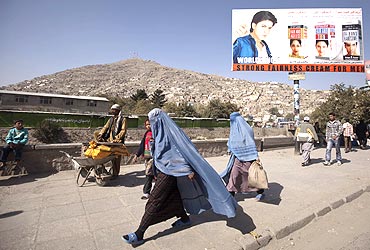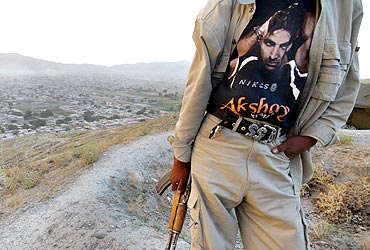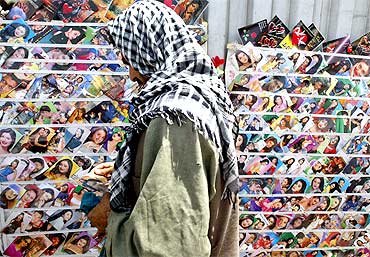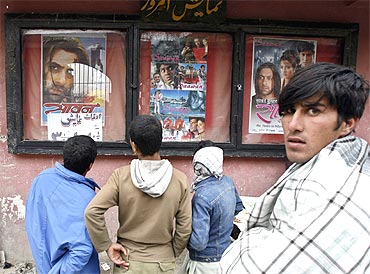 | « Back to article | Print this article |
Afghanistan's love affair with Bollywood
"Swagatam! Yeh aapka pehla visit hai?"
For a moment, I was stunned when Ahmad Zaher Faqiri, the Afghan foreign ministry spokesman, spoke to me in chaste Hindi during my first encounter with him in Kabul.
The handsome Afghan diplomat had more in store for me when he belted the popular song 'Pehla nasha, pehla khumaar, naya pyaar hai, naya intezaar....," from Bollywood movie Jo Jeeta Wohi Sikandar, to relate my first visit to Kabul.
Faqiri is not the only one in war-torn Afghanistan who is influenced by Hindustan (as India is known in this country) and its famous films.
Reportage: Anil K Joseph in Kabul
Afghanistan's love affair with Bollywood
Despite the resurgence of Taliban and their austere moral code, Afghan people's love for India and its culture remains unaffected, officials said.
"Mujhe Hindustani film achchha lagta hai," said a gun-totting Afghan police officer.
"Watching an entertaining Hindi film is one way to relax after a day's tension-ridden duty along with United States-led multinational forces in Kabul's sensitive diplomatic area," he said.
Afghanistan was one of the biggest foreign markets for Bollywood films until the early 1990s. Amitabh Bachchan, Dharmendra and Hema Malini still have a fan-following here.
Afghanistan's love affair with Bollywood
Newer actors like Shah Rukh Khan, Hrithik Roshan, John Abraham and Katrina Kaif too have developed vast admirers among Afghan youngsters who watch Hindi movies on local TV channels and through DVDs in bigger cities like Kabul, Kandahar and Mazar-e-Sharif.
Bollywood broke new ground in Afghanistan in 2006 with the release of Kabul Express, the first international movie filmed in post-Taliban Afghanistan. India's traditionally friendly ties with Afghanistan have been on a high since the fall of the Taliban in 2001.
India is the sixth largest donor to the country with an aid budget of $1.3 billion, and Indian companies are rebuilding roads and schools in this country despite constant security threats. India and Afghanistan have established a strong relationship based on their historical and civilisational ties and strengthened New Delhi's role in the reconstruction of the war-scarred nation.
Afghanistan's love affair with Bollywood
"The principal objective of India's development partnership is to build indigenous Afghan capacity and institutions," officials said.
India has played an active role in the development of Afghanistan based on the understanding that social and economic development is key to the country becoming a source of regional stability.
The India Cultural Centre was inaugurated in Kabul in 2007, reflecting the close cultural links between the two countries.
Through its diverse activities, including conduct of Indian classical music and yoga classes, the ICC has become a place where people of diverse backgrounds come together in the spirit of mutual bonding, Indian officials said.
Afghanistan's love affair with Bollywood
India's aid programmes cover four broad areas -- infrastructure projects, humanitarian assistance, small and community-based development projects and education and capacity development.
The 218-km-long road from Zaranj to Delaram in south- western Afghanistan that facilitates movement of goods and services is a landmark project undertaken by India
India has also erected a 202 km-long 220 KV transmission line from Pul-e-Khumri to Kabul and a 220/110/20 KV sub-station at Chimtala to bring electricity to the Afghan capital from Uzbekistan.
Two other major infrastructure projects, the construction of the Afghan Parliament in Kabul and Salma Dam power project in Heart province, are under progress and would be completed by 2011-12.
Nearly 3,500 Indian nationals are estimated to be currently working in Afghanistan. Many of them are engaged in various aid projects undertaken by the Indian government and private businesses.




